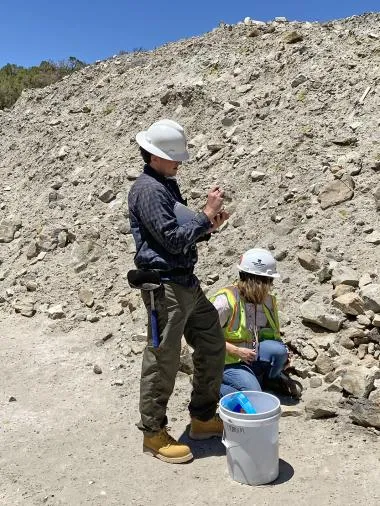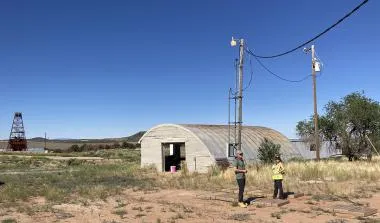Published in February 2021
Two University of Arizona students recently gained uncommon access to Energy Fuels facilities to separately trace the life of a uranium-vanadium deposit—how it got there and how can it be extracted. This was made possible partially thanks to UArizona alumni within the company.

Eytan Bos Orent and Molly Radwany taking samples
Geosciences master’s student Eytan Bos Orent is taking a look at how prehistoric subterranean fluids deposited uranium and vanadium in the La Sal mine area of the Paradox Basin, which straddles Utah and Colorado with small portions in Arizona and New Mexico.
Molly Radwany, pursuing a master’s in mining and geological engineering, is studying the characteristics of the same uranium-vanadium deposits in hopes of learning how some of the minerals can interfere with metal extraction.
Both of these projects were conducted at Utah facilities of Energy Fuels Inc., which is the leading U.S. producer of uranium. Its president and chief executive officer is UArizona alumnus Mark Chalmers.
“It’s very difficult to get into old uranium and vanadium mines,” Dr. Isabel Barton says, who is Radwany’s thesis adviser and also works with Bos Orent. Closed mines are either covered over or fenced off. That leaves longtime operational mines that require permission from the company to gain access. “It’s very important to be able to see ores in situ. (Energy Fuels was) able to provide us with a look at an orebody in its natural habitat.”
Barbara Filas, a UArizona alumna, put the partnership in motion by setting up a meeting with the researchers, Chalmers and company geologists to tour the La Sal mine and the White Mesa mill, which processes the ore and extracts the metal. “The alumni connection was certainly beneficial,” Barton says.
It was thanks to this connection that Bos Orent was able to access the core samples and high-grade piles of mined ores at the La Sal mine. He used them to note interesting geologic features and to take samples for lab analysis. Energy Fuels Chief Geologist Dan Kapostasy also made himself available to answer Bos Orent’s questions and smooth the way to work at the site.
Bos Orent’s project is one part of the huge, multidisciplinary study of the Paradox Basin funded by the W. Keck Foundation. In his study with Dr. Mark Barton, co-director of the Lowell Institute for Mineral Resources, he is mapping out the features left by prehistoric fluid-rock systems that led to various mineral deposits.
“Geologists have hypothesized that it was oil-bearing fluids or other bleaching fluids that altered the rocks from red to white, and provided the right chemical conditions for later fluids to precipitate and deposit metals like uranium and vanadium,” Bos Orent says. “This is one of the fundamental questions I have been trying to answer for the deposits at La Sal.”
Understanding how uranium and vanadium have been deposited under these conditions provides another way to search for potential exploration opportunities.
The nature of the deposits is part of Radwany’s project, too. She is focusing on geometallurgical techniques to characterize vanadium within other ore deposits.
Geometallurgy—a discipline that incorporates geology into mineral processing—has been around as an idea for decades, but its use has increased in recent years as computerization automates a lot of the heavy-lifting analyses. Companies and researchers can gather many times more data on the mineralogy and chemistry of their ores than they could before, which better informs their metallurgical planning by reducing time spent crunching numbers and letting them focus on the issues faced in the field.

Radwany also took samples from the La Sal mine. She plans to use them for leaching tests, then later to examine the residues to see where vanadium is being lost to tailings. Establishing a better idea of where vanadium lies in the tailings could improve its recovery at the mill, Radwany said in her master’s project proposal. The secret to reaching the mineral "is likely related to mineralogy, as the vanadium is hosted in a variety of ore minerals.” Her examination would help to understand the leachability of vanadium and uranium from various mineral deposits.
Just like in Bos Orent’s study, Radwany’s vanadium project adds to the toolkit that geologists can use in looking for productive deposits, but also to the methods metallurgists can use to determine how to extract the desired mineral.
“By adding to our knowledge of these deposits we are able to work with a better understanding of what is possible to be seen while searching for them,” says Bos Orent. “The more we understand them, the better we are at picking them out.
UArizona alumni in this story
Mark S. Chalmers
While pursuing his Bachelor of Science at the University of Arizona, Mark Chalmers was already making his way in the mining industry. He worked as a mine leasor with Union Carbide Corp. After earning his undergraduate degree in mining engineering in 1980, he worked as a mining superintendent for Energy Fuels, among other positions. As senior vice president with Heathgate Resources, he was responsible for the Beverley Mine in South Australia. As executive general manager with Paladin Energy Ltd., he oversaw two mining operations in Namibia and Malawi. He interspersed his corporate work with consulting and advisory roles in the uranium industry, including for BHP Billiton, Rio Tinto and Marubeni. Chalmers rejoined Energy Fuels in 2016 as chief operating officer, by 2017 picked up the title of president and added chief executive officer the next year.
Barbara Filas
After earning a bachelor’s degree in mining engineering from the University of Arizona in 1978, Barbara Filas established herself as an internationally recognized expert on environmental and social responsibility in the mining industry. She has spent over 35 years in the industry, including serving as president of Geovic Mining Corp. and holding a director’s position with Moroccan Minerals Ltd. Previously, she was president and chief executive of the mining and environmental consulting firm Knight Piésold and Co. Now, she’s a partner of Filas Engineering and Environmental Services LLC. A third-generation miner, Filas is a Medal of Merit recipient in the Mining Foundation of the Southwest’s Hall of Fame. She also chairs the board of governors for the National Mining Hall of Fame & Museum.

